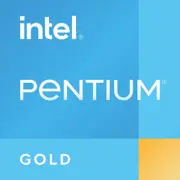Intel Pentium Gold G5420T

Intel Pentium Gold G5420T: Budget Processor for Basic Tasks in 2025
April 2025
Key Features: Coffee Lake Architecture and Modest Performance
The Intel Pentium Gold G5420T processor, released in 2019, remains a viable option for budget builds thanks to its low power consumption and affordable price (around $55–65 in 2025).
Architecture and Process Technology:
- Codename — Coffee Lake, 14nm technology.
- 2 cores / 4 threads (Hyper-Threading).
- Base frequency — 3.2 GHz (no Turbo Boost).
- Integrated graphics: Intel UHD Graphics 610 (base frequency 350 MHz).
- TDP — 35 W, making it ideal for compact systems.
Performance:
- In Geekbench 6 (2025): 695 points (single-thread), 1404 points (multi-thread).
- For comparison: The modern Celeron G6900 (2023) scores about 850 points in the single-thread test but costs $20 more.
Key Features:
- Low heat output — suitable for passive cooling.
- 4K support via HDMI 1.4 (maximum 30 Hz) and DisplayPort 1.2.
- Virtualization (VT-x) and hardware encryption (AES-NI).
Compatible Motherboards: LGA 1151 Socket and 300-Series Chipsets
The G5420T requires a motherboard with LGA 1151 (revision 2) socket. However, not all chipsets support the processor out of the box.
Recommended Chipsets:
1. H310 — the most budget-friendly option (starting at $45). Suitable for office PCs but limited to 2 DDR4 slots and lacks USB 3.1 Gen2.
2. B360/B365 — the optimal choice (starting at $60). Comes with 4 RAM slots, M.2 for NVMe, and USB 3.1.
3. H370 — for those needing RAID support (starting at $75).
Important:
- A BIOS update may be required for motherboards released before 2019.
- Avoid Z390 chipsets — their functionality is excessive for the Pentium.
Practical Example: The ASRock B365M-HDV motherboard ($65) is a good compromise between price and functionality.
Supported Memory: Only DDR4
The G5420T works with DDR4-2400 MHz (official support). The maximum capacity is 64 GB, but for most tasks, 8–16 GB will suffice.
Recommendations:
- Use dual-channel mode: 2 modules of 4 GB instead of one 8 GB — this will provide a +15% boost to graphics performance.
- Compatible modules: Kingston ValueRAM DDR4-2400 (8 GB — $25), Crucial DDR4-2666 (compatible but will operate at 2400 MHz).
Limitations:
- DDR5 and LPDDR4x are not supported.
Power Supply: Saving Watts
With a TDP of 35 W and no discrete graphics card, the system will suffice with a 300–400 W power supply.
Examples:
- Be Quiet! System Power 10 350W ($45) — quiet, with an 80+ Bronze rating.
- EVGA 400 BR ($35) — a basic option for office PCs.
Tip: If you plan to upgrade (for instance, adding a graphics card), choose a 500 W PSU (Corsair CX550 — $60).
Pros and Cons of the Pentium Gold G5420T
Pros:
- Energy efficiency: A PC with this CPU consumes ~50 W under load.
- Low price: A bundle of “processor + motherboard + RAM” will cost about $150–200.
- Quiet operation: A cooler up to 40 mm high is sufficient (Noctua NH-L9i — $45).
Cons:
- Weak multi-threading potential: 4 threads are not enough for rendering or streaming.
- Outdated graphics: UHD 610 can only handle 4K video and 2010s games at low settings (CS:GO runs at 30–40 fps in 720p).
- No support for PCIe 4.0/5.0.
Use Cases: Who Is This Processor For?
1. Office Tasks: Document work, browsing (10+ tabs), Zoom.
2. Multimedia: Watching 4K videos (via VLC with hardware acceleration), streaming Netflix.
3. Light Gaming:
- Minecraft (60 fps in 720p),
- Stardew Valley (stable 60 fps),
- League of Legends (40–50 fps in 1080p on low settings).
4. Home Server/NAS: Suitable for 24/7 operation due to low TDP.
Real-world example: A user built a media center on the G5420T using an InWin Chopin case ($90), connected it to a TV, and uses it for streaming TV and emulating older games (up to PS2).
Comparison with Competitors
1. AMD Athlon 3000G (Zen, 14nm):
- Pros: Unlocked multiplier, Vega 3 graphics (20% faster than UHD 610).
- Cons: Higher TDP (35 W vs. 54 W for AMD), more expensive ($70 in 2025).
2. Intel Celeron G6900 (Alder Lake, 10nm):
- Pros: Higher IPC, DDR5 support, priced at $75.
- Cons: No Hyper-Threading (2 cores / 2 threads).
Conclusion: The G5420T only competes successfully when building the absolute cheapest system.
Practical Assembly Tips
1. Case: Choose models with limited cooling options (Fractal Design Core 500 — $60).
2. Storage: Always include an SSD (Kingston A400 240 GB — $30). An HDD will slow down the system.
3. Cooling: The stock cooler is adequate, but replace it with an Arctic Alpine 12 ($15) for quieter operation.
4. Networking: Add a Wi-Fi module (Intel AX210 — $25) if the motherboard lacks a wireless adapter.
Final Conclusion: Who Is the Pentium Gold G5420T For?
This processor is a good choice if:
- You need a PC for study or text work under $200.
- A quiet and compact system is required (for instance, in a living room).
- You are building a NAS or router with data storage functions.
Why is it still relevant in 2025? Despite its age, the G5420T remains one of the most affordable CPUs with DDR4 and 4K support. However, for gaming or video editing, it's better to pay extra for the Celeron G6900 or AMD Ryzen 3 5300G.
Summary: The Intel Pentium Gold G5420T is a "workhorse" for undemanding tasks. Its main advantages are price and energy efficiency, but the system does not anticipate future upgrades.
Basic
CPU Specifications
Memory Specifications
GPU Specifications
Miscellaneous
Benchmarks
Compared to Other CPU
Share in social media
Or Link To Us
<a href="https://cputronic.com/en/cpu/intel-pentium-gold-g5420t" target="_blank">Intel Pentium Gold G5420T</a>